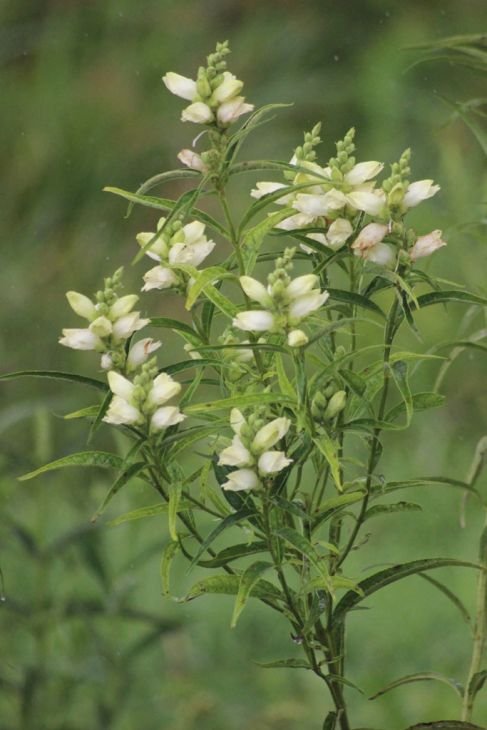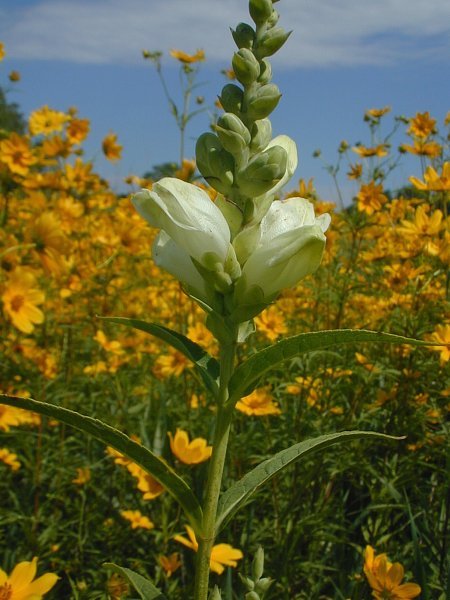Chelone glabra, Turtlehead, Quart pot
Chelone glabra, Turtlehead
FS-PS, Zone 3, Blooms July - September, 5’ x 2-3’, Moisture - Wet to Medium-wet, Deer resistant
Turtlehead is named for its pretty white blossoms which resemble a turtles head poking out from its shell. It is an important host plant that provides larval food for the lovely orange and brown Baltimore Checkerspot Butterfly which has one brood in June - August in the north. It is also the host plant for the Common Buckeye Butterfly. Its nectar also attracts other butterflies, bumblebees, and ruby-throated hummingbirds. Turtlehead likes wet to moist soils and full to part sun. The plants have deep green foliage of lance-shaped leaves on upright stems and grow to 5 feet tall. They make a good choice for border and wet meadow plantings and will bloom in the late summer.
Chelone produces a tap root and rhizomes which may form a small colony.
An easy way to propagate Turtlehead is by Winter Sowing. Spread the seeds out in the fall and slightly push them under the surface of the ground.. The winter weather will naturally stratify the seeds.
Birds are also attracted to the nutrient-dense seeds.
Chelone glabra, Turtlehead
FS-PS, Zone 3, Blooms July - September, 5’ x 2-3’, Moisture - Wet to Medium-wet, Deer resistant
Turtlehead is named for its pretty white blossoms which resemble a turtles head poking out from its shell. It is an important host plant that provides larval food for the lovely orange and brown Baltimore Checkerspot Butterfly which has one brood in June - August in the north. It is also the host plant for the Common Buckeye Butterfly. Its nectar also attracts other butterflies, bumblebees, and ruby-throated hummingbirds. Turtlehead likes wet to moist soils and full to part sun. The plants have deep green foliage of lance-shaped leaves on upright stems and grow to 5 feet tall. They make a good choice for border and wet meadow plantings and will bloom in the late summer.
Chelone produces a tap root and rhizomes which may form a small colony.
An easy way to propagate Turtlehead is by Winter Sowing. Spread the seeds out in the fall and slightly push them under the surface of the ground.. The winter weather will naturally stratify the seeds.
Birds are also attracted to the nutrient-dense seeds.
Chelone glabra, Turtlehead
FS-PS, Zone 3, Blooms July - September, 5’ x 2-3’, Moisture - Wet to Medium-wet, Deer resistant
Turtlehead is named for its pretty white blossoms which resemble a turtles head poking out from its shell. It is an important host plant that provides larval food for the lovely orange and brown Baltimore Checkerspot Butterfly which has one brood in June - August in the north. It is also the host plant for the Common Buckeye Butterfly. Its nectar also attracts other butterflies, bumblebees, and ruby-throated hummingbirds. Turtlehead likes wet to moist soils and full to part sun. The plants have deep green foliage of lance-shaped leaves on upright stems and grow to 5 feet tall. They make a good choice for border and wet meadow plantings and will bloom in the late summer.
Chelone produces a tap root and rhizomes which may form a small colony.
An easy way to propagate Turtlehead is by Winter Sowing. Spread the seeds out in the fall and slightly push them under the surface of the ground.. The winter weather will naturally stratify the seeds.
Birds are also attracted to the nutrient-dense seeds.
Photo credits, Photo #1 - Prairie Moon, Photo #2 - Illinois Wildflowers

